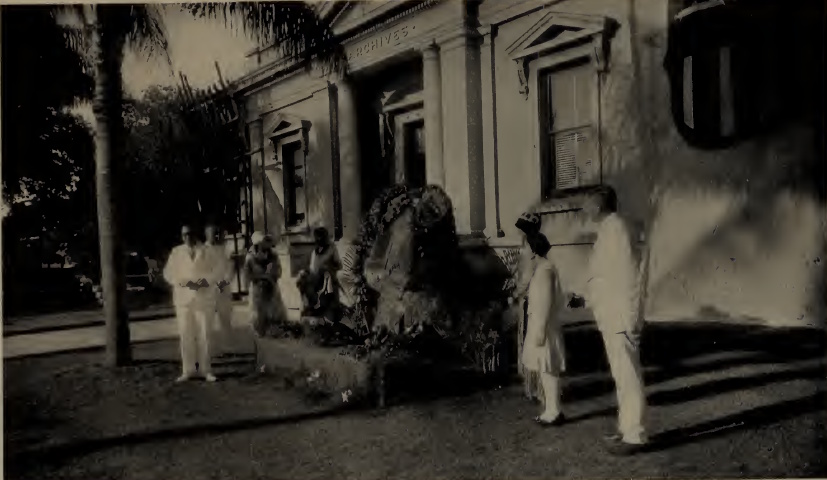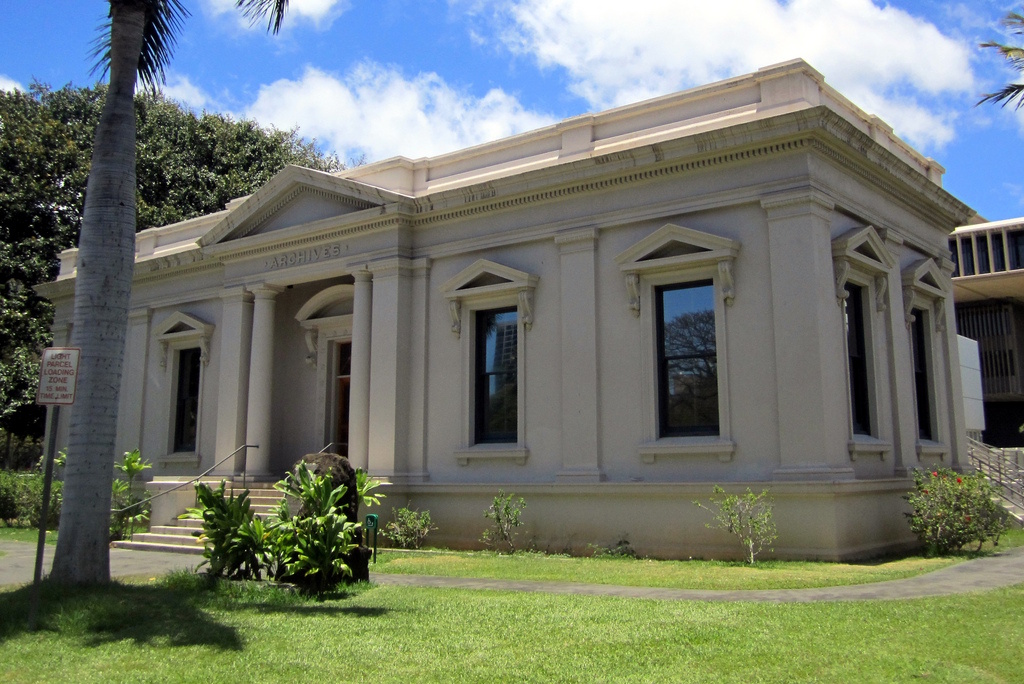Mauna Loa (“long mountain”) is the world’s largest active volcano and probably the largest single mountain mass of any sort on earth. It rises 13,679-feet above sea level, and about 31,000-feet above its base at the ocean floor.
(Of course this relates to surface volcanoes – Tamu Massif, a rounded dome in the northwest Pacific, measures about 280 by 400 miles, or more than 100,000 square miles and lies about 6,500 feet below the ocean surface (Mauna Loa measures about 2,000 square miles.))
Mauna Loa’s volume is of the order of 10,000 cubic miles, as compared to 80 cubic miles for the big cone of Mount Shasta in California. This huge bulk has been built almost entirely by the accumulation of thousands of thin flows of lava, the individual flows averaging only about 10 feet in thickness. (NPS)
The enormous volcano covers half of the Island of Hawai`i and by itself amounts to about 85 percent of all the other Hawaiian Islands combined. (USGS)
Mauna Loa has grown rapidly during its relatively short (600,000 to 1,000,000-years) history. Detailed geologic research on the volcano has nevertheless shown that about 98-percent of the volcano’s surface is covered with lava flows less than 10,000 years old. (USGS)
Since 1832, Mauna Loa has erupted 39 times; its last eruption started in 1984. According to USGS estimates, the volcano has erupted an average of once every 6 years over the past 3000. (SOEST)
The Ahupua‘a of Kapapala encompasses both the summit area and eastern flanks of Mauna Loa; this relatively large ahupua‘a extends from the coastline (Nāpu‘uonā‘elemākule to Keauhou) to the summit of Mauna Loa and Moku‘āweoweo Caldera. (NPS)
The large size of the ahupua‘a may be accounted for because the area contains limited natural resources within its boundaries: coastal resources most likely provided residences with rich marine resources; upland areas were rich in forest resources (e.g. forest birds, canoe material). However, the remaining portions of the ahupua‘a include the vast Ka‘u desert. (NPS)
The first modern climb of Mauna Loa was made by Archibald Menzies, the acclaimed naturalist and botanist serving with Captain George Vancouver on the Discovery.
In February 1794, after receiving advice and assistance from King Kamehameha (guides, attendants and transportation to the southern point of the island,) Menzies and the team reached the summit (fueled by rations consisting of few ship’s biscuits, a bottle of rum, some chocolate and a few coconuts.) (NPS)
Later, between December 1840 and January 1841, the US Exploring Expedition, led by Lt. Charles Wilkes, was the first US exploring and surveying expedition to the South Seas.
“(I)t was my intention to proceed to Hawaiʻi, there to ascend to the top of Mauna Loa; to make the pendulum observations on the summit and at the base of that mountain; to examine the craters and late eruptions”. (Wilkes 1845)
The expedition team was supported by a throng of porters that stretched out across the landscape and Wilkes described the scene as consisting of “…200 bearers of burdens, forty hogs, a bullock and bullock hunter …”
“… fifty bearers of poe (native food), twenty-five with calabashes…lame horses, which, instead of carrying their riders, were led by them; besides a large number of hangers-on, in the shape of mothers, wives, and children, equaling in number the bearers, all grumbling and complaining of their loads…”(Wilkes, NPS)
Once at the summit, a camp (called Pendulum Peak) was set up with rock walls to buttress tents against the extreme weather conditions, and the expedition could carry out observations and mapping.
The expedition mapped the summit region and conducted scientific efforts in the relatively unknown alpine wilderness area. The culmination of the Expedition coincided with the establishment of the Smithsonian Institution and the Natural Museum of Natural History. (NPS)
Land Commission testimony (1845) notes that sandalwood was an important resource, “When the people used to go after sandalwood the Alii of Kapapala Naihe and Aikanaka took it for Kaaumanu.”
“The Kaalaala people went after sandalwood for their chief but the people of the other lands in Kau used to go after sandalwood on Kapapala and take to their chiefs. This was the last gathering of sandalwood for Kamehameha III to pay the debt.” (NPS)
After the Mahele of 1848, the lands of Kapapala were retained as crown lands under Kauikeaouli (Kamehameha III). Upon his death, the title to the land was transferred to his successor, Kamehameha IV, who ruled the islands from 1854-1863. The land remained as crown lands until the overthrow of the Hawaii Monarchy in 1893. (NPS)
Others later climbed the mountain: “Struggling, slipping, tumbling, jumping, ledge after ledge was surmounted, but still, upheaved against the glittering sky, rose new difficulties to be overcome. Immense bubbles have risen from the confused masses, and bursting, have yawned apart.…”
“Earthquakes have riven the mountain, splitting its sides and opening deep crevasses, which must be leapt or circumvented. … stepping over deep cracks, which, perhaps, led down to the burning, fathomless sea, traversing hilly lakes ruptured by earthquakes …”
“… and split in cooling into a thousand fissures, painfully toiling up the sides of the mounds of scoriae frothed with pumice-stone, and again for miles surmounting rolling surfaces of billowy, ropy lava – so passed the long day, under the tropic sun and the deep blue sky.” (Isabella Bird, 1875)
Starting in 1906, George Lycurgus (early operator of the Volcano House) and newspaperman Lorrin Andrews Thurston were working to have the Mauna Loa and Kilauea Volcanoes area made into a National Park. In 1912, geologist Thomas Augustus Jaggar arrived to investigate and joined their effort.
In September 1915, Jaggar, Thurston and a US Army representative conducted a survey to determine a route for a trail up Mauna Loa. The following month, a local paper noted, “Soldiers Building Mountain Trail. Negro soldiers of the Twenty-fifth Infantry to the number of 150 are at work constructing a trail from near the Volcano House to the summit of Mauna Loa.”
“It is estimated that three or four weeks will be devoted to this work. The soldiers are doing the work as a part of their vacation exercises.” (Maui News, October 29, 1915)
The Buffalo Soldiers built the 18-mile trail to the summit of Mauna Loa. They also built the ten-man Red Hill Cabin and a twelve-horse stable, so scientists could spend extended periods of time studying the volcano.
On August 1, 1916, President Woodrow Wilson signed the country’s 13th National Park into existence – Hawaiʻi National Park. At first, the park consisted of only the summits of Kīlauea and Mauna Loa on Hawaiʻi and Haleakalā on Maui. On, July 1, 1961, Hawaiʻi National Park’s units were separated and re-designated as Haleakalā National Park and Hawaiʻi Volcanoes National Park.













































